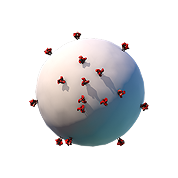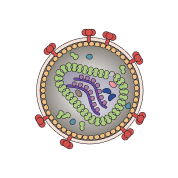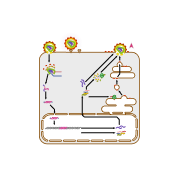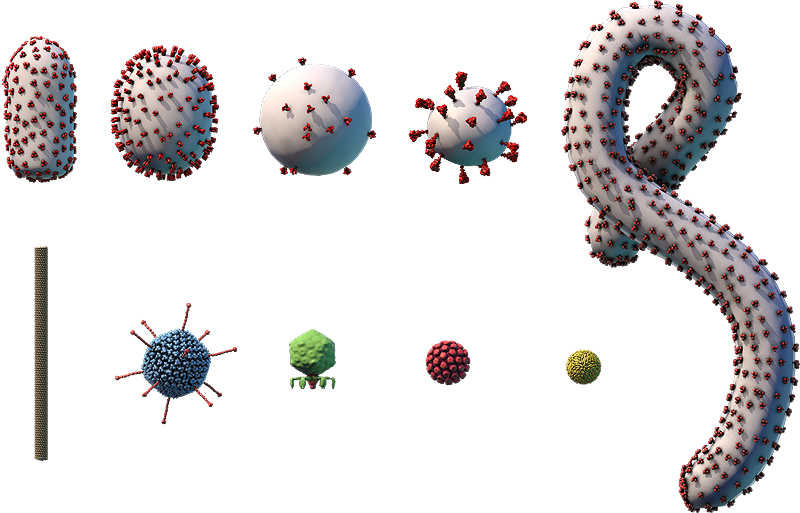Virus Explorer
Click and drag or use the buttons below to move the model.
Use the tab to focus one of the buttons above, and then space to start the rotation.
The viral envelope (gray) and proteins embedded in the envelope (red) are shown.
Components on the virus are selectively represented in the 3D model for educational purposes.
A. Glycoprotein; B. Reverse transcriptase; C. Integrase; D. Protease; E. Nucleocapsid protein; F. RNA genome; G. Capsid protein; H. Matrix protein; I. Lipid envelope
This diagram shows how HIV replicates, or makes copies of itself. Glycoproteins on the surface of HIV bind to specific receptors on the host cell’s surface (A). This triggers the cell membrane to fuse with the virus’s envelope, releasing the virus’s (+)RNA genome and viral proteins, including reverse transcriptase and integrase, into the cell’s cytosol (B).
The viral reverse transcriptase transcribes the virus’s (+)RNA genome into complementary DNA (cDNA) in a process known as reverse transcription (C). This is then used to make a dsDNA copy of the virus’s genome. The DNA copy travels to the nucleus and is inserted into the cell’s genome by the viral integrase.
The viral genome is transcribed by the host machinery alongside the host genome (D). This produces more copies of the virus’s (+)RNA genome (E), as well as mRNAs (F). The mRNAs leave the nucleus and are translated into proteins by ribosomes in the cytosol and on the endoplasmic reticulum (ER) (G). HIV glycoproteins are further modified through protein processing in the ER-Golgi network (H), then are transported to the cell membrane.
Viral genomes and proteins assemble into new viruses at the cell surface (I), which leave the cell through a process known as budding (J). This process surrounds the virus in a piece of the cell membrane containing viral proteins, which becomes the virus’s envelope.
Human Immunodeficiency Virus (HIV)
- Part of the Retroviridae family
- ~120-nm enveloped particles with a conical capsid
- Linear (+)ssRNA genome of ~9,700 bp
- Thought to have evolved from the simian immunodeficiency virus (SIV); HIV is a distinct virus that infects humans
- Vaccines are currently being tested
HIV was first recognized in humans in the 1980s. The virus infects and destroys immune cells, which means that, as the infection progresses, people lose their ability to fight off disease. Acquired immunodeficiency syndrome (AIDS) refers to the advanced stages of HIV infection, when a person’s immune system is severely impaired.
Because HIV can permanently incorporate its genome into that of a host cell, the infection lasts a lifetime. There is currently no vaccine against HIV, although numerous drugs can keep infection at bay and hinder disease progression. Nearly 38 million people worldwide were infected with HIV by the end of 2019, and an estimated 2 million new infections occur every year.
Worldwide Prevalence of HIV
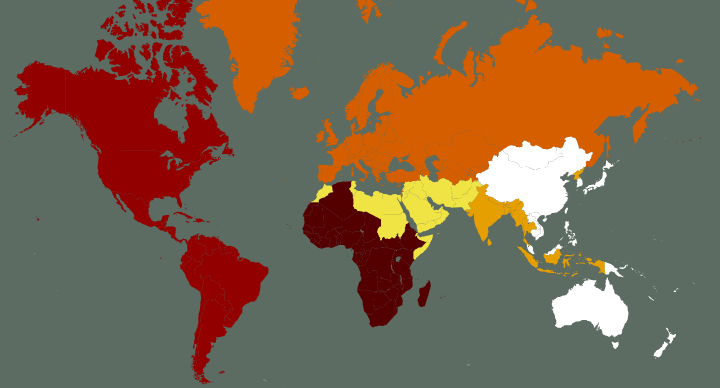
Adult HIV prevalence (%) in 2014, by region
- Western Pacific: 0.1
- Eastern Mediterranean: 0.1
- South East Asia: 0.3
- Europe: 0.4
- Americas: 0.5
- Africa: 4.5
